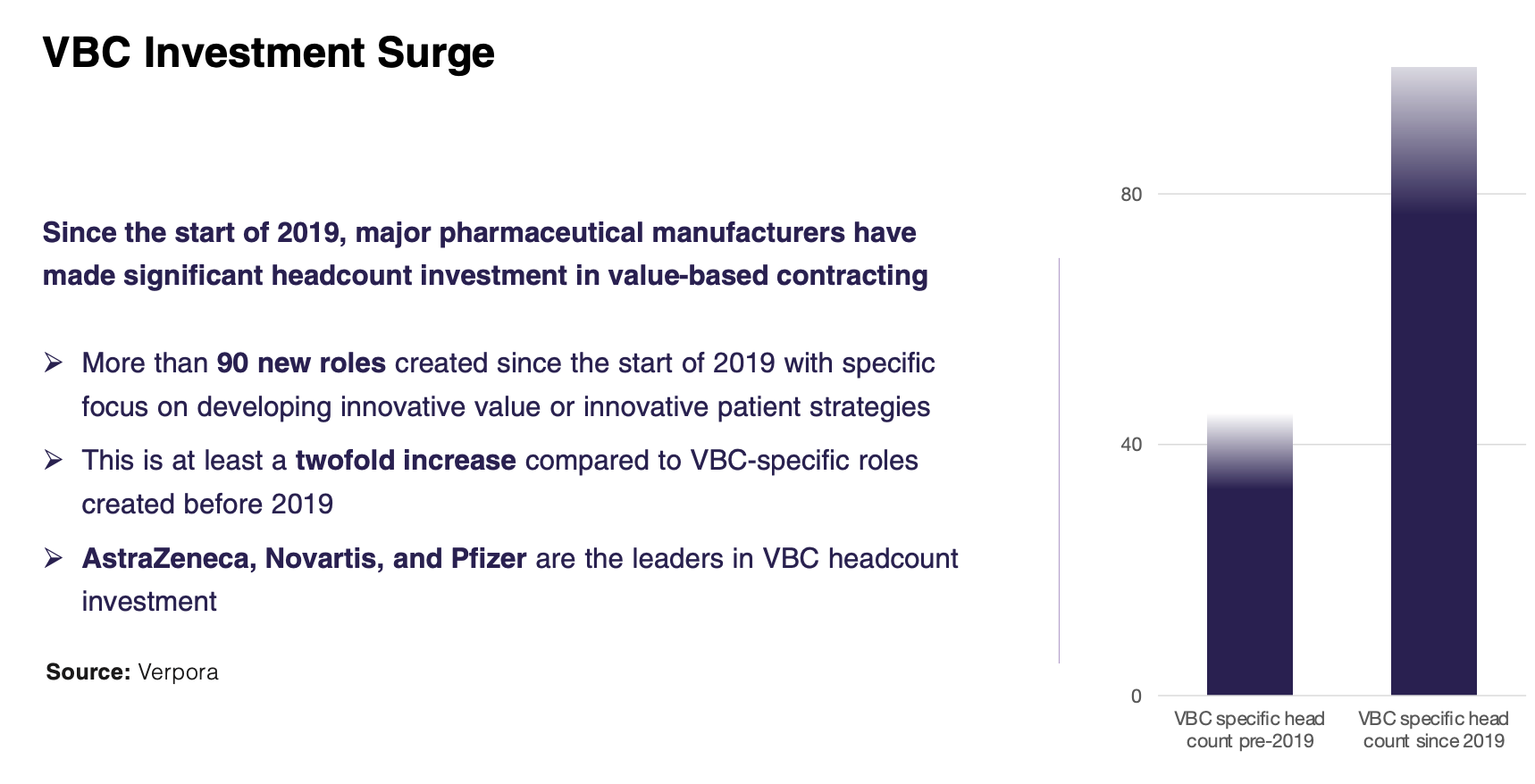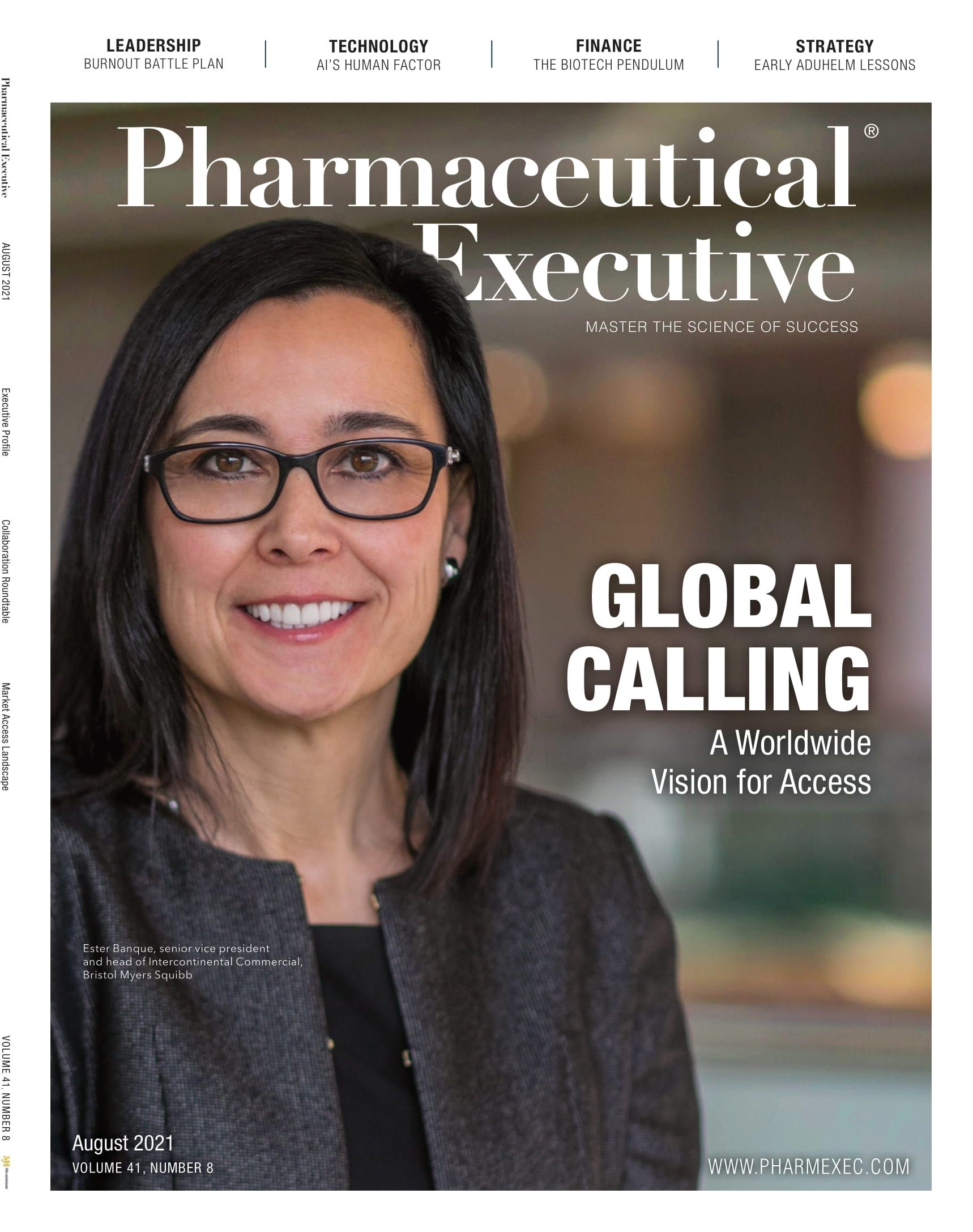- Sustainability
- DE&I
- Pandemic
- Finance
- Legal
- Technology
- Regulatory
- Global
- Pricing
- Strategy
- R&D/Clinical Trials
- Opinion
- Executive Roundtable
- Sales & Marketing
- Executive Profiles
- Leadership
- Market Access
- Patient Engagement
- Supply Chain
- Industry Trends
Value Risk and Reward: Taking Stock of Value-Based Contracts in Pharma
A look at how VBC agreements between drug manufacturers and payers—which reimburse for pre-specified treatment outcomes—have measured up so far in reducing healthcare costs, and the opportunities still untapped to drive true value for both sides and the patients they serve.
What do Jardiance, Stelara, Aimovig, Brilinta, Tecfidera, Simponi Aria, Trulicity, and 42 other brand name treatments have in common?
If you said, “They all have innovative contracts that landed them on at least one formulary,” you’d be correct. Truth be told, these were among the published 77 value-based contracts (VBC) signed between 2009 and 2021, according to The Pharmaceutical Research and Manufacturers of America (PhRMA). By 2015, there were 15 such agreements, so the bulk have come in the last four years. Granted, a small portion compared to those in the volume-based contract bucket.
But that portion, measured in other ways, is expanding in the number of pharma professionals dedicated to market access, in the literature count discussing it, and in the number of consultancies dedicated to making these deals. “Value-based has spawned a whole new industry,” says Rob Nauman, principal, BioPharma Advisors.
As to why there are so few agreements: Families of devils lurk in these details. Getting to the “sign here, please” line takes time, negotiation skills, persistence, and in the end, a firm belief that the contract will do good.
“These are reasonable people trying to come to a reasonable conclusion,” says Steven Pearson, founder, Institute for Clinical and Economic Research (ICER). (See a past profile of Pearson by Pharm Exec here. In the end, he says, the “central core” of these negotiations is about helping patients and providing them access to medications.
What pharma likes about these contracts is that they zero in on the right patients. They also can eliminate more ineffective drugs in a formulary. Payers like them because their financial risk is mitigated; they find out the extent of the patient population, and they get a better picture of the drug’s efficacy. A major part of these contracts involves the collection and assessment of real-world evidence (RWE), their outcomes used to judge whether contract stipulations have been met. In short, they alleviate uncertainty and help control risk.

“Value-based agreements provide an opportunity to demonstrate our full portfolio and the value our medicines bring to patients by tying access to outcomes,” says Don Sawyer, senior vice president, US market access, AstraZeneca. Indranil Bagchi, global head, value and access, oncology, Novartis, agrees: “We want value, not volume.”
That said, there is “nothing easy” to negotiate in a VBC, Bagchi says, which can take a couple of years to negotiate. The deals are complicated, the infrastructure requirements are extensive, and they depend on trust on all sides.
The success of a VBC, says Sawyer, requires that both sides accept risk. For the risk averse, that might be a deal breaker. “However, when both sides are willing to accept some risk for the betterment of patient outcomes, it can usually be salvaged in the end.
Definitions, details, and devils
VBCs have evolved for primarily three reasons: an attempt to drive down the costs of pharmaceuticals; to fulfill the payers’ need to know if the drug’s efficacy lives up to pharma’s claims; and as already mentioned, to spread the risk that both manufacturer and payer take to get a drug into a physician’s, and ultimately a patient’s, hands.
The unofficial definition of a VBC: Practically any agreement between manufacturer and payer that is not rooted in volume. A literature-based definition: Agreements that link “price, amount, or nature of drug reimbursements to value-based outcomes.”1
“There are many definitions of a value-based contract,” says Adam Meads, head of research, analytics and chief operating officer, Verpora, a market-access consultancy firm headquartered in the UK.
These contracts also have different names. They can be called outcomes-based contracts and value-based agreements. These are not the same as value-based pricing, which is the goal of ICER, to align the drug’s price to its efficacy.

Noteworthy points: VBCs are fluid. For example, they change if a molecule gets an additional indication or if it enters a more crowded drug class. Verpora’s list of contracts, which goes back to 2009, includes a few renegotiated deals. The first deal on that list was for Actonel (risedronate sodium).

Another example of fluidity comes from Michael Sherman, executive vice president and chief medical officer for Point32Health, formed by the merger of Harvard Pilgrim Health Care and Tufts Health Plan. He said that they have renegotiated several existing formulary therapies, historically around chronic diseases or drugs in different classes, so that they are now subject to a VBC. “This has been a great learning experience for us,” says Sherman. “For example, we’ve learned that given that the contracts require a significant amount of work, it is beneficial to focus on high-cost drugs or drugs for rare diseases where there are limited drugs and limited data on efficacy.”
Which leads directly to Meads’ following scenarios as to why these contracts get made. Uncertainty of a new drug’s performance in the real world, especially if the drug class already has a few winners—or is brand-new—will bring all stakeholders to the table. Affordability is another reason, especially with those medications that offer a cure. The latter will prompt a financial-based (also called a service) agreement, whereby the medication requires a change in clinical protocol, including regular follow-up. In the UK, Meads says, patients who took intravenous medications like Simponi (golimumab) went to hospitals for care, which put hospital staff under a strain. Deals were struck for the manufacturer to pay for home delivery and healthcare for those patients to alleviate that burden.
Contracts can be based on financial risk to improve cost predictability. Financial risks are not linked to health outcomes. They can be caps for spending, population, or volume. In the latter, a manufacturer pays for any amount of medication above the agreed-to amount. The methods of reaching those contract stipulations reveal pharma’s creative bent. Amgen volunteered to pay a provider if a patient on its lipid-lowering drug had a heart attack or stroke; Novartis told its German provider that if anyone experiences a fracture within a year of taking its osteoporosis medication, it would pick up the treatment tab; AstraZeneca permitted its blood thinner to be listed with the generics in one formulary, saving patients the costs of a branded drug.1 In Puerto Rico, the maker of a hepatitis C drug agreed to cover all of the wrap-around services that these patients required, while the territory’s Medicaid administrators accepted the financial risk.2 And in Argentina, says Meads, multiple manufacturers are paying for BRCA genetic testing, an expensive proposition to find the right patients for the right treatment.
As for the devilish details, let’s start with value. There are many factors to consider when it comes to looking at the value of medicine. Beyond its clinical value, there is the value to the patients, irrespective of clinical marker. What is the ultimate impact on them? What is the patient’s quality of life if she is not taking the drug? How does her quality of life improve if she takes it? Improvements in quality of life affect the person’s and society’s economic outcome, as society benefits from reductions in future, related healthcare costs.
Where it becomes tricky, says Pearson, is identifying what matters most to the patient, as they “are hard to find in claims data” or the medical record. And while identifying those needs and wants prompt back-and-forth conversation, it’s the quantitative part of the deal—putting a percentage or dollar amount on those needs—that consumes time. “It takes administrative effort, time, and everything else to monitor these contracts,” he says.
And since it’s obvious that not enough challenges exist to generate a signed deal, here’s another: ensuring that administrative claims data are linked, hassle free, with all electronic medical records (EMRs). No gaps in the data can be allowed, says Bagchi.

When it gets down to the nitty-gritty, says Roshawn Blunt, founder of 1798, a market-access consultancy, now part of healthcare marketing agency FingerPaint, these details are tough to trace in the payer systems. How did the patient respond, for example, and from which database did that information come from? “It’s tough for manufacturers to track,” she says. “They only have so much time to look for a case.” IT connectivity issues complicate the search even more. “Value-based contracts are there, but tactically speaking, the conversation is more [abundant] than the actual contracts,” adds Blunt.
RWE is another negotiated endpoint in the contract. The negotiators must agree on how the data will be aggregated and then adjudicated, regardless of the kind of data. And then the stakeholders must decide if the agreed-to payment aligns with the real-world data.
Bagchi says that all of these complications have resulted in why we don’t see many of these contracts.
Another reason some say there are so few contracts: Many pharma members are reluctant to approach the unmapped waters of safe harbors. In 2019, the Trump administration wanted to eliminate rebate protections affecting Medicare- and Medicaid-covered medications; PhRMA sued in January. The matter remains unresolved. The Centers for Medicare & Medicaid Services (CMS) estimates that nearly $230 million would be saved in four years by allowing pharma to negotiate its best prices countrywide. Providers would be allowed to use different outcomes and RWE, including evidence generated through physician office visits and hospitalizations.3
Some payers are getting their states’ help in amassing provider data. Massachusetts and Minnesota require commercial plans to align on quality measures, and Rhode Island’s state health insurance commissioner requires similar data.4
Importance
One way to judge just how important market access and VBCs have become is the point at which these discussions begin and why. Years ago, Nauman says, they began in Phase III. Today, he says, they start at molecule development. Novartis concurs, and AZ agrees negotiations start early.
Since 2019, the number of positions added to global value-based contracting has gone up. Prior to 2019, 30 to 40 roles, globally speaking, were dedicated to value-based agreements. Since the start of 2019, 90 new roles were added, says Verpora’s Meads (see chart on previous page).
The number of articles in the literature regarding cost effectiveness analysis grew to 500 per year between 2010 and 2014, up from 34 per year during the 2000s.5
Another way to judge is how early and often participants engage in meetings. In a recent Pharm Exec article, the author noted R&D organizations can work hand in hand with payers earlier in the development process (ideally prior to a drug’s Phase II clinical trials) with the overarching goal of favorable coverage and reimbursement decisions.6
In 2018, FDA provided its “Drug and Device Manufacturer Communications With Payers, Formulary Committees, and Similar Entities—Questions and Answers.” The guidance addresses common questions around how a manufacturer communicates healthcare economic information regarding their prescription drugs to payers, formulary committees, or other similar. It covers information dissemination for products not yet approved, or unapproved uses of already approved products.

Those early meetings now include regulators, say those interviewed. This way, regulators can discuss the amount of data and so on that they need to consider approval—and everyone can hear what the payers need in terms of the data to get that drug on their formulary. “We seek early advice with all stakeholders so when the data [are available] everyone is on the same page,” says Bagchi.
Sherman looks to the FDA’s varying approval processes. “To the extent that more drugs are coming to the market through the accelerated approval process, particularly where the clinical impact of the biomarkers is not universally agreed to by experts, having the pharmaceutical companies enter into value-based contracts could help facilitate access and reduce payer concerns about the drugs not having the impact that we all want them to have,” he says.
In the UK, the Medicines and Healthcare Products Regulatory Agency and NICE seek evidence jointly, says Meads. NICE is advising pharma on trial endpoints. “Regulators, payers, and manufacturers are getting closer together,” he says. “Especially around data infrastructure. A lot of people are pairing up. The loop is being very much closed.”
These contracts also play an important role around product launch. “Market access today is a critical component of launches,” says Blunt. The drug profile, the patient demographics, the issue of cost—who is driving uptake? “Is the provider most important to driving uptake? Or is it the patient, or payer? If you don’t get past [the payer], you won’t get to the provider,” she adds.
When 1798 has conversations with a new client, says Blunt, the meat of the matter is the patients—who they are, what they need, how to support them. “We are not starting with, what discount do I need to do this?” she says.
Other stakeholders are sometimes included in the negotiations; one researcher noted the inclusion of patients and advisory groups in the discussion. “This has made market access an increasingly important area of focus for pharmaceutical companies to achieve success through improved access,” the researcher said.7
The results of these conversations factor into clinical trial design. Before, says Bagchi, pharma solely depended on trial results to be the burden of proof. Now, the hurdles to pass include producing a first-in-class product that is accessible to patients who need it.
At the table
How do these disparate stakeholders behave when they gather? At ICER’s policy leadership forum, which is held regularly, stakeholders discuss better access for patients, among other issues. Pearson says the participants are cordial. They like an environment in which they can speak freely, discuss the present and future, and learn from each other, he says. Over the past five or six years the group has assembled, they have discussed rebates, gene therapy, evidence—what the good kind looks like—and the length of trials. “Out of that comes people who are more prepared for the future,” says Pearson.
Novartis has been a consistent attendee over the years. Over time, interactions have become more cordial, according to Bagchi. “We understand each other’s space,” he says. “Through this mutual dialogue and interaction, each other’s position becomes clearer and more transparent. We all have a purpose.”

In the US, Meads says, value-based contracting is a process to try and control prices charged to the patient. But just having a discussion creates the opportunity for others to appreciate the concerns of other stakeholders. “It is the act of discussion that brings about empathy for all those involved,” he says.
Good manners notwithstanding, sometimes the deals fall through. Blunt recounts two stories from over 10 years ago. One client wanted to enter an already crowded therapeutic space that had three therapies that dominated the market. “We were willing to offer [an extensive] discount just to get covered in the formulary,” she says. But the payers made more money, due to the volume, with a small reduction from the others, she says. The payers wouldn’t even consider RWE to prove superiority.
The game plan changed; Blunt and her team targeted smaller payers. By starting smaller, she says, pharma can “get the access [it] is looking for.”
The second tale: A payer wanted a VBC for an antibiotic that would move from an inpatient to outpatient hospital setting. The payer received the VBC, as requested. They said it was too complex, and opted for a traditional deal.
The lack of framework to conduct these conversations is a barrier. Wrote one researcher in 2017, “The absence of an effective guiding framework to generate, implement, coordinate [a value-based contract] has historically been hindered by a series of factors, including the availability, consistency, and reliability of patient data; selection of appropriate conditioning outcomes; and alignment of data needs and expectations between partners.”8
These frameworks exist in some European countries because they generally have single-payer systems and, therefore, fewer stakeholders to contend with. Italy built its framework in 2012; Spain the following year, says Meads. One community in Spain built its own IT tools to monitor these contracts. Data sets are linked with a unique personal health ID, and the system monitors data to the patient level.9
In the US, both pharma and managed care plans should be collecting the data, says Blunt. “This is a dialogue. You don’t ever want a one-sided conversation.”
Sherman says, “We are still in the early innings in regards to value-based contracts. There are some payers that have entered into these agreements, but it is still viewed as leading edge and not the standard process. There is certainly opportunity for these to grow, but both payers and drug companies need to work together to ensure they are not just meant as a press opportunity, but to show real value for our members.”
So, are VBCs worth the time and trouble? At Novartis, they are considered the default method of negotiation. Says Bagchi: “Philosophically, they are the right thing to do. If you promise, you have to deliver on it.”
References
- Joseph T. Kannarkat, Chester B. Good, Natasha Parekh. Value-Based Pharmaceutical Contracts: Value for Whom? Value in Health. 2020; 23(2) pp 154-156.
- Frank Vinluan. Like it or not, value-based contracting is coming for drugs and medical devices. MedCity News. Apr 22, 2021.
- Press release. CMS Issues Final Rule to Empower States, Manufacturers, and Private Payers to Create New Payment Methods for Innovative New Therapies Based on Patient Outcomes. CMS.gov; Dec. 21, 2020.
- Picher C, Block L, Japinga M, Tewarson H. March 2021. State-Driven Initiatives to Support Moving to Value-Based Care in the Era of COVID-19. Washington DC: National Governors Association Center for Best Practices and Duke-Margolis Center for Health Policy.
- James R. Baumgardner, Peter J. Neumann. Balancing The Use of Cost-Effectiveness Analysis Across All Types of Health Care Innovations. Health Affairs. April 14, 2017.
- PIE is Good for You: Drive Patient Access by Embracing FDA’s Final Guidance. https://www.pharmexec.com/view/pie-good-you-drive-patient-access-embracing-fdas-final-guidance
- Anuj Kumar, Karthaveerya Juluru. Pharmaceutical market access in emerging markets: concepts, components, and future. Journal of Market Access & Health Policy. Volume 2, 2014 - Issue 1.
- Tara Nazareth, John J. Ko, Rahul Sasane, et al. Outcomes-Based Contracting Experience: Research Findings from US and European Stakeholders. Journal of Managed Care and Specialty Pharmacy. October 2017.
- McKinsey & Company. Innovative pharma contracts: When do value based arrangements work? October 2017.
Christine Bahls is a freelance writer and researcher based in Pennsylvania

Delivery and Disruption: Navigating a Changing Care Terrain
September 16th 2024The diversification of site-of-care delivery models is accelerating rapidly, creating new go-to-market implications for drug manufacturers—but also new opportunities to drive more fundamental innovation in engagement and access strategies.
